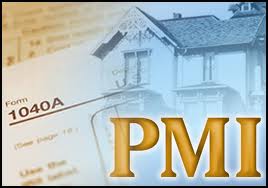As I mentioned sometime ago, in my article Mortgage 101, the typical limit for a well written new mortgage is 80% of the house’s appraised value, or 80% LTV (loan to value.)
But, what if you come up short, and instead of having a full 20% down, you only have 15%. This is when PMI comes into play. PMI, the initials for private mortgage insurance is the fee you’ll pay each month until your loan is down to the 80% of the initial home value. What I want to look at today is the cost of PMI, with a focus on those loans that are at that 15% down range I suggested.
The FHA has recently announced the PMI rates effective June, 2012. The rate is 1.2% for a loan up to $625,000.
Let’s work out the math here. You wish to buy a home that’s at the median $140K or so. You put down 15% or $21K, and the loan value is $119K. The dollar amount you are short from being at the full 20% down is just $7000, but you will pay 1.2% per year on the $119K mortgage, or $1428 per year until the balance is paid down to $112K. On a 4%, 30 year loan, this will take about 3 years, not too bad, but look at the numbers, an annual cost of $1428 because you needed an extra $7000. Let me do the math for you, this is 20.4%. In addition to the interest on the mortgage.
On the other hand, if you only put 5% down, the PMI rate rises to 1.25%. On that same $140K house, your loan is $133K, and your PMI, $1662.50 per year. But, when you consider that you’re paying $1662.50 for the fact that you are short $21,000, it’s more like a 7.9% adder for that missing $21K. Not a great deal, but a far cry from 20%+.
What do I conclude from these numbers? First, I maintain that 20% down is the right thing to do, but if you are close to having the 20%, avoid the 85% LTV, and raise that extra cash however you can. If a small 401(k) loan can help you avoid PMI, do it. If you need to borrow from friends or family, put a plan together, offer them a decent rate, and take that side loan.
Have you ever taken a mortgage that came with the need for PMI? Did you understand how much it was going to cost you?


Borrowing from friends and family at a “decent rate” and thus taking a side loan to get to the 20% down-payment can be hazardous to one’s financial health if the loans are not revealed to the lender on the mortgage application or as soon as the side loan is set in place (if the setting in place happens after the mortgage application but before the closing). There are also side issues with regard to gifting of interest if the side loan is not charging the rate of interest that the IRS regards as reasonable. There is some discussion on money.SE on a related gift issue too.
Dilip – in a sense, I meant to be a bit on the exaggerated side, as in the phrase “beg, borrow, or steal” which I considered using here. You’re right however, my suggestions come with their own risks, one needs to be very careful when raising ‘side funds’ to help finance the house.
Thanks for the link!
Hi Joe,
I’m trying to refinance from a 30 year mortgage to a better rate. I want a new mortage for 42% of the initial mortgage value, combined with a family loan for the remaining 40% at the IRS regulated AFR rate of 2.36%. I imagined that this would be my own version of a combo mortgage/loan (like the 80/10/10 etc) and would bypass the PMI. We put 12.2% down initially.
Is this combo of a mortgage and a private home loan a reasonable method that would not require PMI.
Thanks, TC
If I were a bank, I’d be happy to take a legitimate first position that has such a low debt to equity. In fact, had we a system where banks only funded 50% or less of a home’s value with friends and/or family to fund the rest, the recent crash may not have occurred as it did.
Still, it’s for the individual bank to decide, but I think your chance is pretty good they go for it.